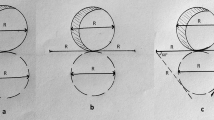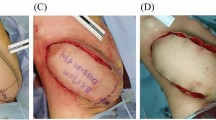Abstract
Background
While sliding-type skin flaps such as advancement and rotation flaps are useful for closing circular skin defects that are too large to close primarily, these flaps are associated with some technical difficulties that must be overcome. In this study, we aimed to present our clinical experience using an alternative curvilinear advancement-transposition flap designed based upon a “flap-to-defect” concept.
Methods
A retrospective review was conducted of patient charts and operative photographs of all “ice cream cone flaps” performed at the Department of Plastic and Reconstructive Surgery between May 2014 and November 2018. This method, for the repair of circular-shaped wounds, is intended to allow appropriate distribution of closure tension without necessitating changing the shape of the defect. Patient age, gender, defect size and region, postoperative complications, and esthetic/functional satisfaction were evaluated.
Results
The technique, based on the planning of a curvilinear advancement flap that mirrors the defect, was used for reconstruction of circular skin defects that involved various parts of the body. Information from 30 patients with defects ranging from 100 × 70 to 20 × 20 mm with a mean diameter of 30.3 × 20.8 mm were reviewed for the study. All flaps survived without wound infection, hematoma, or flap necrosis complications. During the follow-up period, acceptable esthetic results were achieved.
Conclusions
This technique is a good alternative for the closure of small to moderate circular skin defects where adequate skin laxity is present.
Level of evidence: Level IV, therapeutic study.






Similar content being viewed by others
References
Thorne CH (2007) Techniques and principles in plastic surgery. Grabb and Smith’s Plastic Surgery. 6th ed. Lippincott Williams Wilkins, pp 12
Johnson TM, Nelson BR (1992) Aesthetic reconstruction of skin cancer defects using flaps and grafts. Am J Cosmet Surg 9:253–266
Mutaf M, Sunay M, Bulut O (2008) The "reading man" procedure: a new technique for the closure of circular skin defects. Ann Plast Surg 60(4):420–425
Lovald ST, Topp SG, Ochoa JA, Gabal CW (2013) Biomechanics of the monopedicle skin flap. Otolaryngol Head Neck Surg 149(6):858–864
Shew M, Kriet JD, Humphrey D (2017) Flap basics II: advancement flaps. Facial Plast Surg Clin North Am 25(3):323–335
Kalus R, Zamora S (1996) Aesthetic considerations in facial reconstructive surgery: the V-Y flap revisited. Aesthetic Plas Surg 20(1):83–86
Calderón W, Andrades P, Leniz P, Piñeros JL, Llanos S, Roa R, Irribarren O (2004) The cone flap: a new and versatile fasciocutaneous flap. Plast Reconstr Surg 114(6):1539–1542
Swanson NA (1995) Classifications, definitions and concepts in flap surgery. In: Cummings CW (ed) Local flaps in facial reconstruction. Mosby, St. Louis, pp 63–74
Golomb FM (1984) Closure of the circular defect with double rotation flaps and Z-plasties. Plast Reconstr Surg 74(6):813–816
Keser A, Sensöz O, Mengi AS (1998) Double opposing semicircular flap: a modification of opposing Z-plasty for closing circular defects. Plast Reconstr Surg 102(4):1001–1007
Ausín A (1997) The "trap-door" scar deformity. Clin Plast Surg 4(2):255–261
Koranda FC, Webster RC (1997) Trap door effect in nasolabial flaps. Causes and corrections. Arch Otolaryngol 111(7):421–424
Author information
Authors and Affiliations
Corresponding author
Ethics declarations
Conflict of interest
Enver Arpaci declares that there is no conflict of interest.
Ethical approval
This study was performed in accordance with the ethical standards as laid down in the 1964 Declaration of Helsinki and its later amendments or comparable ethical standards. This a retrospective study, the Pamukkale University School of Medicine Research Ethics Committee has confirmed that no ethical approval is required.
Informed consent
Informed consent was obtained from all individual participants included in the study.
Patient consent
Patients signed informed consent regarding publishing their data and photographs. Additional informed consent was obtained from all individual participants for whom identifying information is included in this article.
Additional information
Publisher’s note
Springer Nature remains neutral with regard to jurisdictional claims in published maps and institutional affiliations.
Supplementary information
ESM 1
(DOC 219 kb)
Rights and permissions
About this article
Cite this article
Arpaci, E. “Flap-to-defect” concept for closure of circular skin defects: the ice cream cone flap. Eur J Plast Surg 44, 211–218 (2021). https://doi.org/10.1007/s00238-020-01770-5
Received:
Accepted:
Published:
Issue Date:
DOI: https://doi.org/10.1007/s00238-020-01770-5




